Information Systems and Management
VerifiedAdded on 2020/10/22
|17
|5903
|376
AI Summary
This assignment involves analyzing the importance of information systems in management, including various types such as transactional, decision support, and executive information systems. It also explores different methods like concurrent engineering systems, integrated financial management information systems, and geographic information systems. The analysis covers factors influencing accounting information system alignment, health system performance comparison, and building integrated care systems. Additionally, it discusses the role of information systems in managing organizational risks, developing systemic lessons learned knowledge models, and creating effective online platforms.
Contribute Materials
Your contribution can guide someone’s learning journey. Share your
documents today.
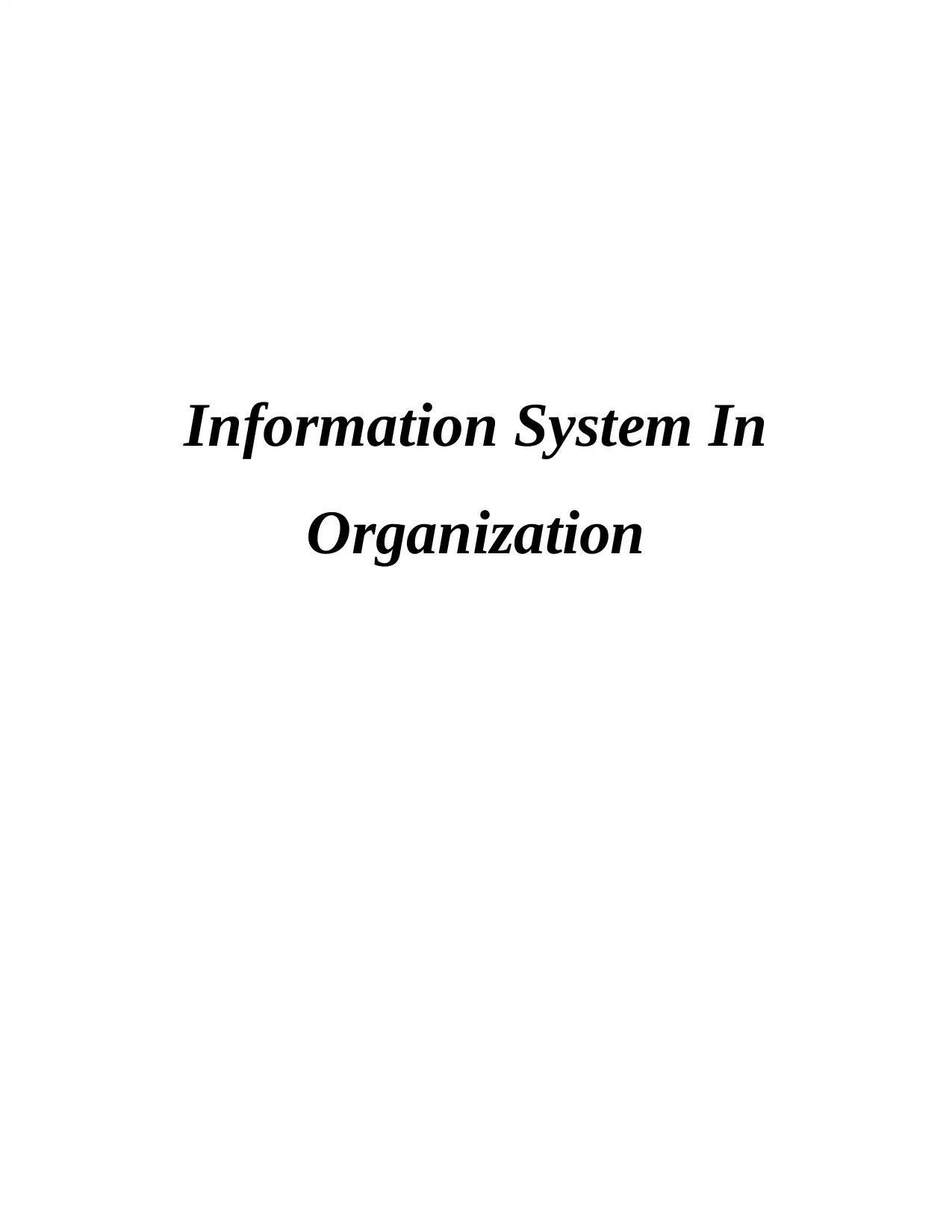
Information System In
Organization
Organization
Secure Best Marks with AI Grader
Need help grading? Try our AI Grader for instant feedback on your assignments.
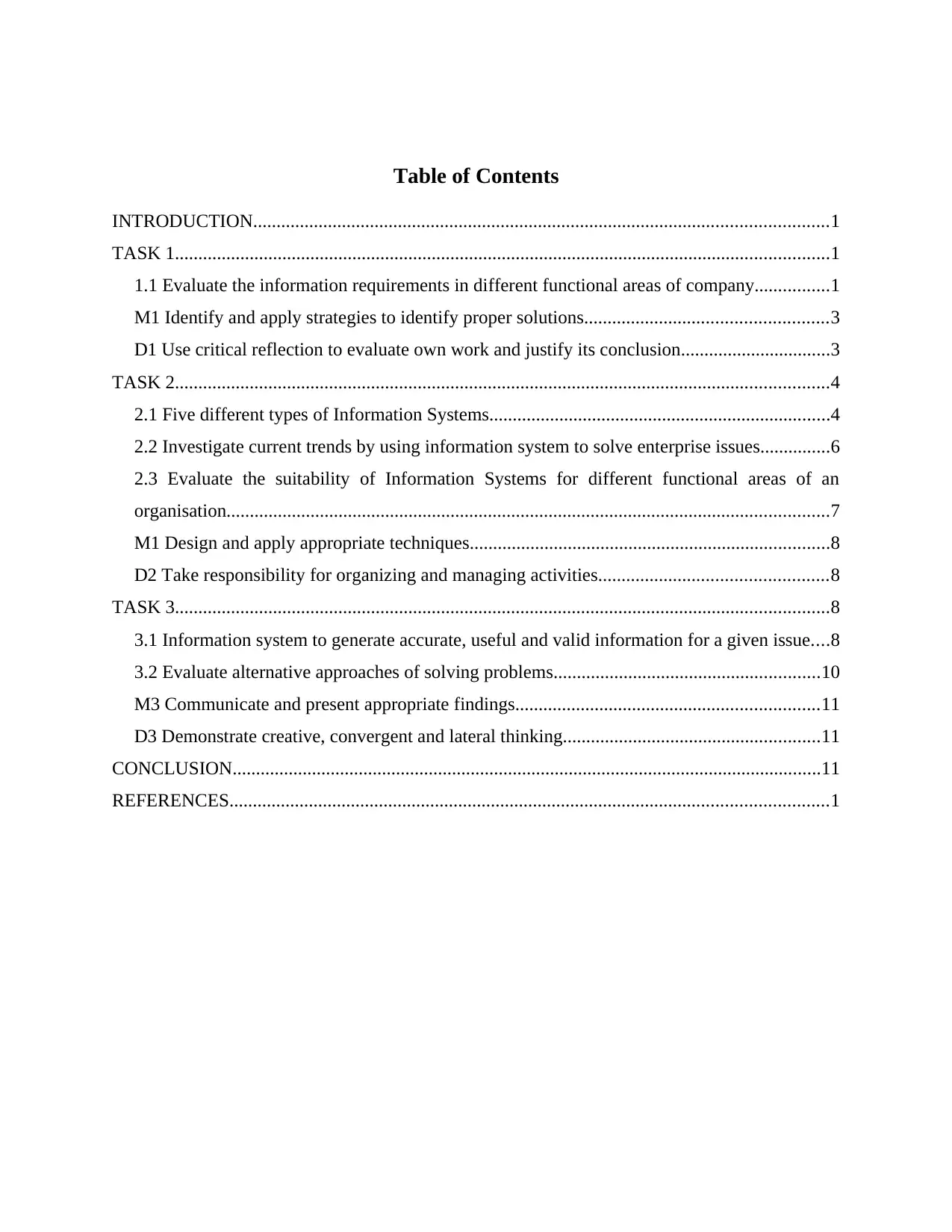
Table of Contents
INTRODUCTION...........................................................................................................................1
TASK 1............................................................................................................................................1
1.1 Evaluate the information requirements in different functional areas of company................1
M1 Identify and apply strategies to identify proper solutions....................................................3
D1 Use critical reflection to evaluate own work and justify its conclusion................................3
TASK 2............................................................................................................................................4
2.1 Five different types of Information Systems.........................................................................4
2.2 Investigate current trends by using information system to solve enterprise issues...............6
2.3 Evaluate the suitability of Information Systems for different functional areas of an
organisation.................................................................................................................................7
M1 Design and apply appropriate techniques.............................................................................8
D2 Take responsibility for organizing and managing activities.................................................8
TASK 3............................................................................................................................................8
3.1 Information system to generate accurate, useful and valid information for a given issue....8
3.2 Evaluate alternative approaches of solving problems.........................................................10
M3 Communicate and present appropriate findings.................................................................11
D3 Demonstrate creative, convergent and lateral thinking.......................................................11
CONCLUSION..............................................................................................................................11
REFERENCES................................................................................................................................1
INTRODUCTION...........................................................................................................................1
TASK 1............................................................................................................................................1
1.1 Evaluate the information requirements in different functional areas of company................1
M1 Identify and apply strategies to identify proper solutions....................................................3
D1 Use critical reflection to evaluate own work and justify its conclusion................................3
TASK 2............................................................................................................................................4
2.1 Five different types of Information Systems.........................................................................4
2.2 Investigate current trends by using information system to solve enterprise issues...............6
2.3 Evaluate the suitability of Information Systems for different functional areas of an
organisation.................................................................................................................................7
M1 Design and apply appropriate techniques.............................................................................8
D2 Take responsibility for organizing and managing activities.................................................8
TASK 3............................................................................................................................................8
3.1 Information system to generate accurate, useful and valid information for a given issue....8
3.2 Evaluate alternative approaches of solving problems.........................................................10
M3 Communicate and present appropriate findings.................................................................11
D3 Demonstrate creative, convergent and lateral thinking.......................................................11
CONCLUSION..............................................................................................................................11
REFERENCES................................................................................................................................1
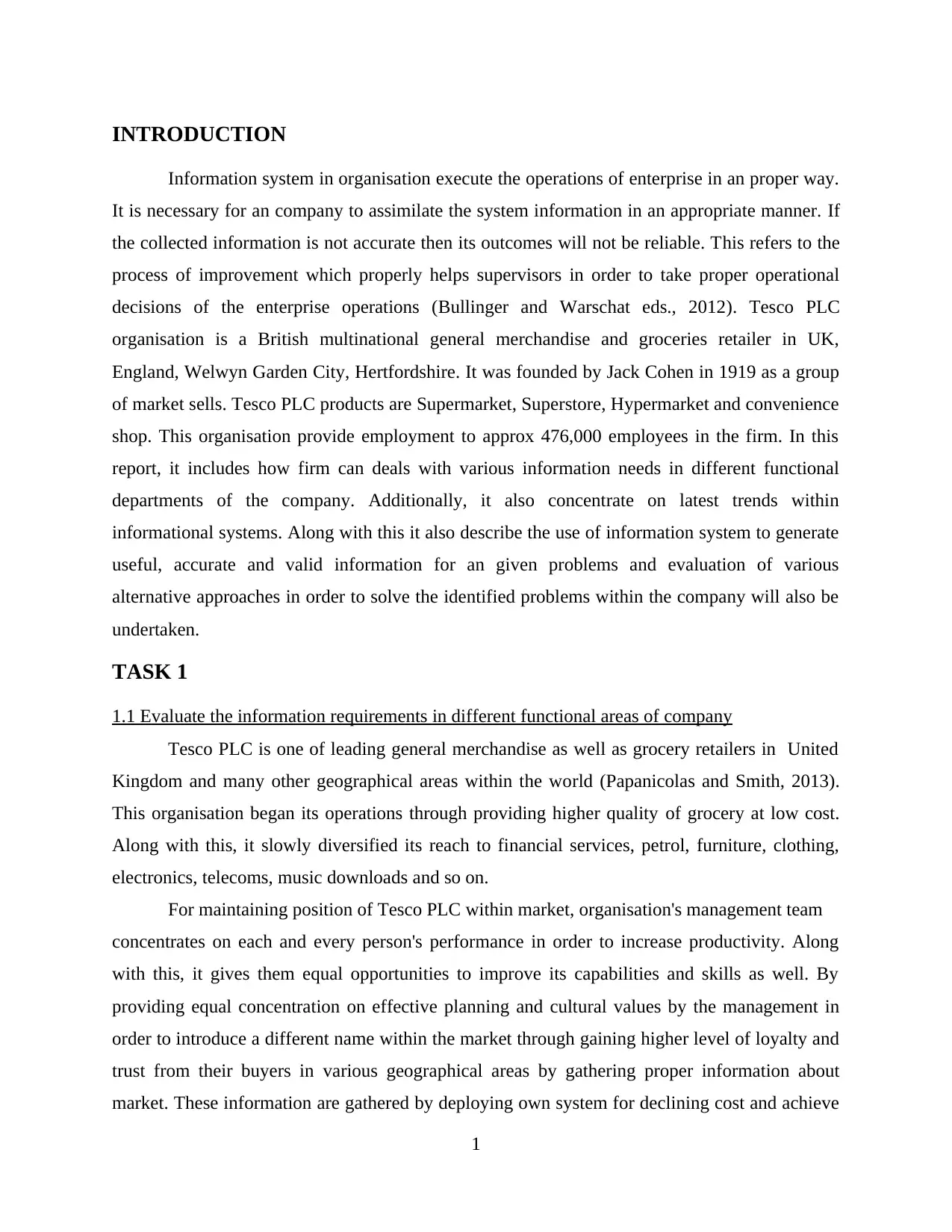
INTRODUCTION
Information system in organisation execute the operations of enterprise in an proper way.
It is necessary for an company to assimilate the system information in an appropriate manner. If
the collected information is not accurate then its outcomes will not be reliable. This refers to the
process of improvement which properly helps supervisors in order to take proper operational
decisions of the enterprise operations (Bullinger and Warschat eds., 2012). Tesco PLC
organisation is a British multinational general merchandise and groceries retailer in UK,
England, Welwyn Garden City, Hertfordshire. It was founded by Jack Cohen in 1919 as a group
of market sells. Tesco PLC products are Supermarket, Superstore, Hypermarket and convenience
shop. This organisation provide employment to approx 476,000 employees in the firm. In this
report, it includes how firm can deals with various information needs in different functional
departments of the company. Additionally, it also concentrate on latest trends within
informational systems. Along with this it also describe the use of information system to generate
useful, accurate and valid information for an given problems and evaluation of various
alternative approaches in order to solve the identified problems within the company will also be
undertaken.
TASK 1
1.1 Evaluate the information requirements in different functional areas of company
Tesco PLC is one of leading general merchandise as well as grocery retailers in United
Kingdom and many other geographical areas within the world (Papanicolas and Smith, 2013).
This organisation began its operations through providing higher quality of grocery at low cost.
Along with this, it slowly diversified its reach to financial services, petrol, furniture, clothing,
electronics, telecoms, music downloads and so on.
For maintaining position of Tesco PLC within market, organisation's management team
concentrates on each and every person's performance in order to increase productivity. Along
with this, it gives them equal opportunities to improve its capabilities and skills as well. By
providing equal concentration on effective planning and cultural values by the management in
order to introduce a different name within the market through gaining higher level of loyalty and
trust from their buyers in various geographical areas by gathering proper information about
market. These information are gathered by deploying own system for declining cost and achieve
1
Information system in organisation execute the operations of enterprise in an proper way.
It is necessary for an company to assimilate the system information in an appropriate manner. If
the collected information is not accurate then its outcomes will not be reliable. This refers to the
process of improvement which properly helps supervisors in order to take proper operational
decisions of the enterprise operations (Bullinger and Warschat eds., 2012). Tesco PLC
organisation is a British multinational general merchandise and groceries retailer in UK,
England, Welwyn Garden City, Hertfordshire. It was founded by Jack Cohen in 1919 as a group
of market sells. Tesco PLC products are Supermarket, Superstore, Hypermarket and convenience
shop. This organisation provide employment to approx 476,000 employees in the firm. In this
report, it includes how firm can deals with various information needs in different functional
departments of the company. Additionally, it also concentrate on latest trends within
informational systems. Along with this it also describe the use of information system to generate
useful, accurate and valid information for an given problems and evaluation of various
alternative approaches in order to solve the identified problems within the company will also be
undertaken.
TASK 1
1.1 Evaluate the information requirements in different functional areas of company
Tesco PLC is one of leading general merchandise as well as grocery retailers in United
Kingdom and many other geographical areas within the world (Papanicolas and Smith, 2013).
This organisation began its operations through providing higher quality of grocery at low cost.
Along with this, it slowly diversified its reach to financial services, petrol, furniture, clothing,
electronics, telecoms, music downloads and so on.
For maintaining position of Tesco PLC within market, organisation's management team
concentrates on each and every person's performance in order to increase productivity. Along
with this, it gives them equal opportunities to improve its capabilities and skills as well. By
providing equal concentration on effective planning and cultural values by the management in
order to introduce a different name within the market through gaining higher level of loyalty and
trust from their buyers in various geographical areas by gathering proper information about
market. These information are gathered by deploying own system for declining cost and achieve
1
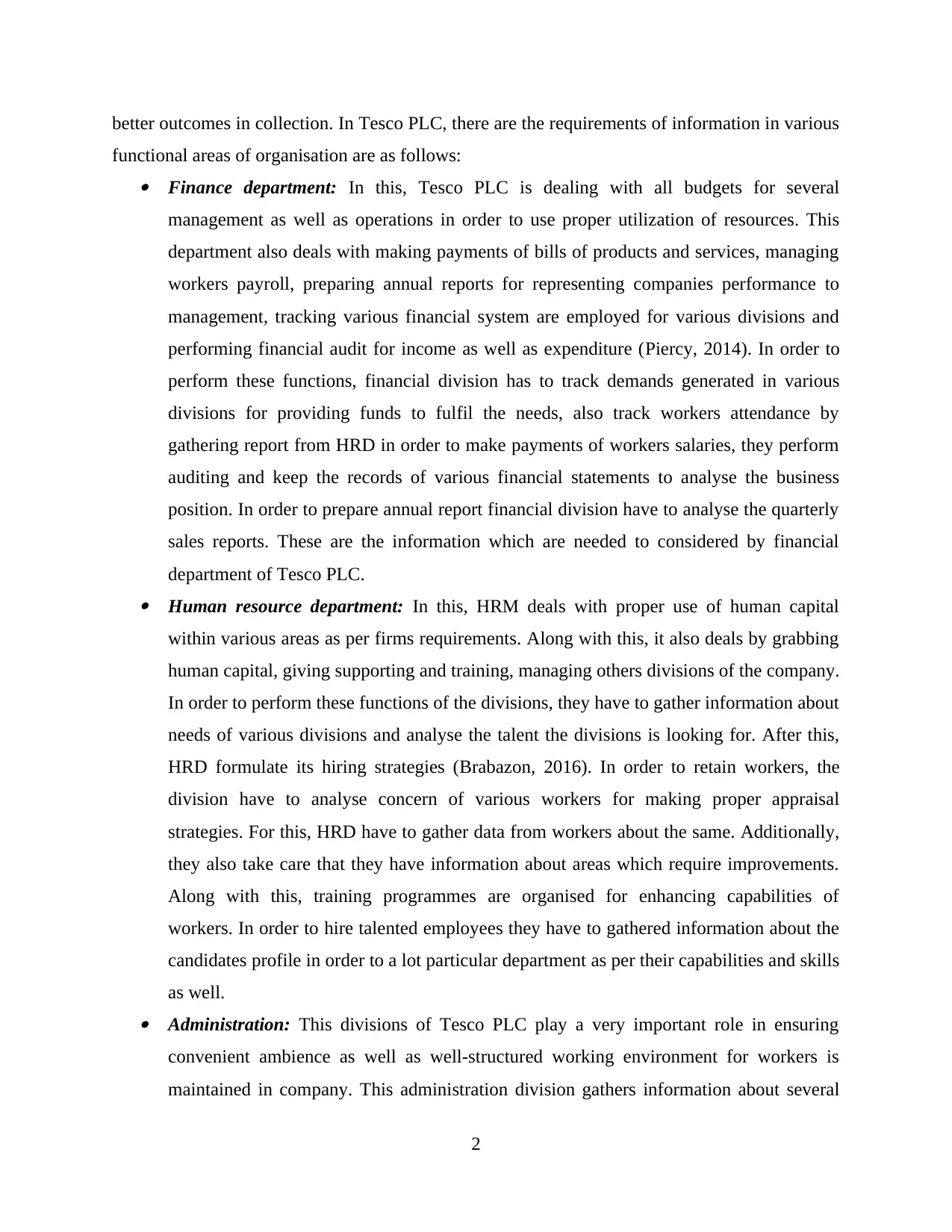
better outcomes in collection. In Tesco PLC, there are the requirements of information in various
functional areas of organisation are as follows: Finance department: In this, Tesco PLC is dealing with all budgets for several
management as well as operations in order to use proper utilization of resources. This
department also deals with making payments of bills of products and services, managing
workers payroll, preparing annual reports for representing companies performance to
management, tracking various financial system are employed for various divisions and
performing financial audit for income as well as expenditure (Piercy, 2014). In order to
perform these functions, financial division has to track demands generated in various
divisions for providing funds to fulfil the needs, also track workers attendance by
gathering report from HRD in order to make payments of workers salaries, they perform
auditing and keep the records of various financial statements to analyse the business
position. In order to prepare annual report financial division have to analyse the quarterly
sales reports. These are the information which are needed to considered by financial
department of Tesco PLC. Human resource department: In this, HRM deals with proper use of human capital
within various areas as per firms requirements. Along with this, it also deals by grabbing
human capital, giving supporting and training, managing others divisions of the company.
In order to perform these functions of the divisions, they have to gather information about
needs of various divisions and analyse the talent the divisions is looking for. After this,
HRD formulate its hiring strategies (Brabazon, 2016). In order to retain workers, the
division have to analyse concern of various workers for making proper appraisal
strategies. For this, HRD have to gather data from workers about the same. Additionally,
they also take care that they have information about areas which require improvements.
Along with this, training programmes are organised for enhancing capabilities of
workers. In order to hire talented employees they have to gathered information about the
candidates profile in order to a lot particular department as per their capabilities and skills
as well. Administration: This divisions of Tesco PLC play a very important role in ensuring
convenient ambience as well as well-structured working environment for workers is
maintained in company. This administration division gathers information about several
2
functional areas of organisation are as follows: Finance department: In this, Tesco PLC is dealing with all budgets for several
management as well as operations in order to use proper utilization of resources. This
department also deals with making payments of bills of products and services, managing
workers payroll, preparing annual reports for representing companies performance to
management, tracking various financial system are employed for various divisions and
performing financial audit for income as well as expenditure (Piercy, 2014). In order to
perform these functions, financial division has to track demands generated in various
divisions for providing funds to fulfil the needs, also track workers attendance by
gathering report from HRD in order to make payments of workers salaries, they perform
auditing and keep the records of various financial statements to analyse the business
position. In order to prepare annual report financial division have to analyse the quarterly
sales reports. These are the information which are needed to considered by financial
department of Tesco PLC. Human resource department: In this, HRM deals with proper use of human capital
within various areas as per firms requirements. Along with this, it also deals by grabbing
human capital, giving supporting and training, managing others divisions of the company.
In order to perform these functions of the divisions, they have to gather information about
needs of various divisions and analyse the talent the divisions is looking for. After this,
HRD formulate its hiring strategies (Brabazon, 2016). In order to retain workers, the
division have to analyse concern of various workers for making proper appraisal
strategies. For this, HRD have to gather data from workers about the same. Additionally,
they also take care that they have information about areas which require improvements.
Along with this, training programmes are organised for enhancing capabilities of
workers. In order to hire talented employees they have to gathered information about the
candidates profile in order to a lot particular department as per their capabilities and skills
as well. Administration: This divisions of Tesco PLC play a very important role in ensuring
convenient ambience as well as well-structured working environment for workers is
maintained in company. This administration division gathers information about several
2
Secure Best Marks with AI Grader
Need help grading? Try our AI Grader for instant feedback on your assignments.
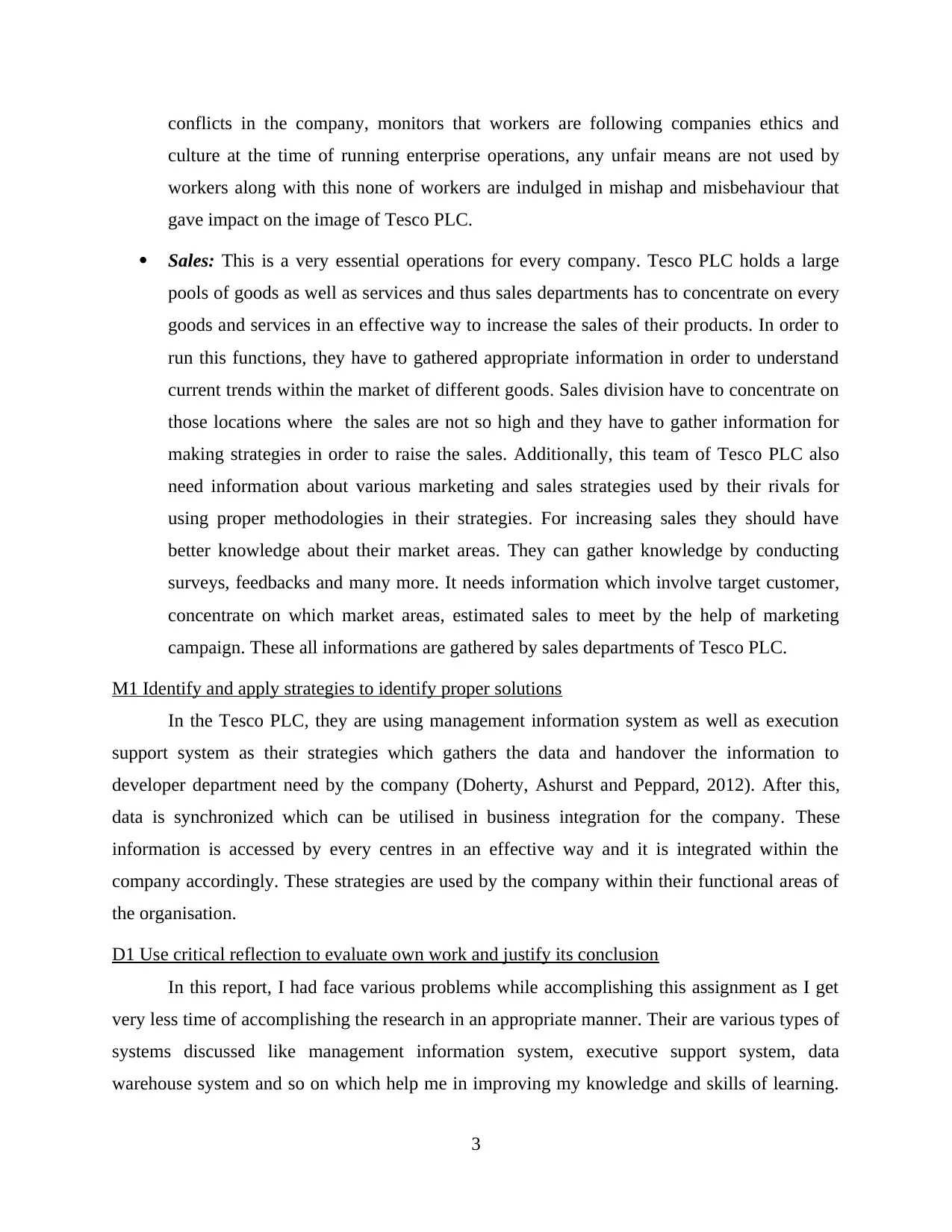
conflicts in the company, monitors that workers are following companies ethics and
culture at the time of running enterprise operations, any unfair means are not used by
workers along with this none of workers are indulged in mishap and misbehaviour that
gave impact on the image of Tesco PLC.
Sales: This is a very essential operations for every company. Tesco PLC holds a large
pools of goods as well as services and thus sales departments has to concentrate on every
goods and services in an effective way to increase the sales of their products. In order to
run this functions, they have to gathered appropriate information in order to understand
current trends within the market of different goods. Sales division have to concentrate on
those locations where the sales are not so high and they have to gather information for
making strategies in order to raise the sales. Additionally, this team of Tesco PLC also
need information about various marketing and sales strategies used by their rivals for
using proper methodologies in their strategies. For increasing sales they should have
better knowledge about their market areas. They can gather knowledge by conducting
surveys, feedbacks and many more. It needs information which involve target customer,
concentrate on which market areas, estimated sales to meet by the help of marketing
campaign. These all informations are gathered by sales departments of Tesco PLC.
M1 Identify and apply strategies to identify proper solutions
In the Tesco PLC, they are using management information system as well as execution
support system as their strategies which gathers the data and handover the information to
developer department need by the company (Doherty, Ashurst and Peppard, 2012). After this,
data is synchronized which can be utilised in business integration for the company. These
information is accessed by every centres in an effective way and it is integrated within the
company accordingly. These strategies are used by the company within their functional areas of
the organisation.
D1 Use critical reflection to evaluate own work and justify its conclusion
In this report, I had face various problems while accomplishing this assignment as I get
very less time of accomplishing the research in an appropriate manner. Their are various types of
systems discussed like management information system, executive support system, data
warehouse system and so on which help me in improving my knowledge and skills of learning.
3
culture at the time of running enterprise operations, any unfair means are not used by
workers along with this none of workers are indulged in mishap and misbehaviour that
gave impact on the image of Tesco PLC.
Sales: This is a very essential operations for every company. Tesco PLC holds a large
pools of goods as well as services and thus sales departments has to concentrate on every
goods and services in an effective way to increase the sales of their products. In order to
run this functions, they have to gathered appropriate information in order to understand
current trends within the market of different goods. Sales division have to concentrate on
those locations where the sales are not so high and they have to gather information for
making strategies in order to raise the sales. Additionally, this team of Tesco PLC also
need information about various marketing and sales strategies used by their rivals for
using proper methodologies in their strategies. For increasing sales they should have
better knowledge about their market areas. They can gather knowledge by conducting
surveys, feedbacks and many more. It needs information which involve target customer,
concentrate on which market areas, estimated sales to meet by the help of marketing
campaign. These all informations are gathered by sales departments of Tesco PLC.
M1 Identify and apply strategies to identify proper solutions
In the Tesco PLC, they are using management information system as well as execution
support system as their strategies which gathers the data and handover the information to
developer department need by the company (Doherty, Ashurst and Peppard, 2012). After this,
data is synchronized which can be utilised in business integration for the company. These
information is accessed by every centres in an effective way and it is integrated within the
company accordingly. These strategies are used by the company within their functional areas of
the organisation.
D1 Use critical reflection to evaluate own work and justify its conclusion
In this report, I had face various problems while accomplishing this assignment as I get
very less time of accomplishing the research in an appropriate manner. Their are various types of
systems discussed like management information system, executive support system, data
warehouse system and so on which help me in improving my knowledge and skills of learning.
3
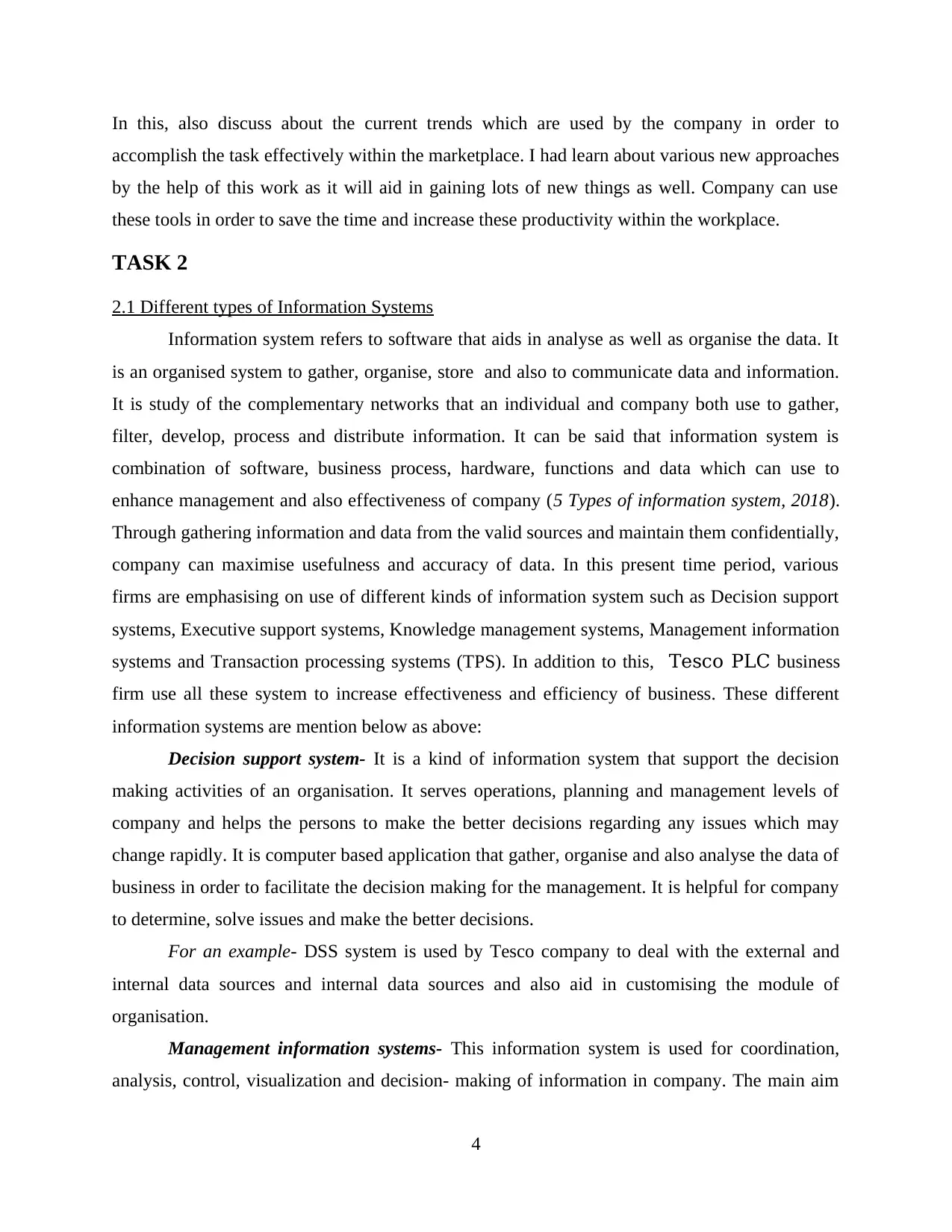
In this, also discuss about the current trends which are used by the company in order to
accomplish the task effectively within the marketplace. I had learn about various new approaches
by the help of this work as it will aid in gaining lots of new things as well. Company can use
these tools in order to save the time and increase these productivity within the workplace.
TASK 2
2.1 Different types of Information Systems
Information system refers to software that aids in analyse as well as organise the data. It
is an organised system to gather, organise, store and also to communicate data and information.
It is study of the complementary networks that an individual and company both use to gather,
filter, develop, process and distribute information. It can be said that information system is
combination of software, business process, hardware, functions and data which can use to
enhance management and also effectiveness of company (5 Types of information system, 2018).
Through gathering information and data from the valid sources and maintain them confidentially,
company can maximise usefulness and accuracy of data. In this present time period, various
firms are emphasising on use of different kinds of information system such as Decision support
systems, Executive support systems, Knowledge management systems, Management information
systems and Transaction processing systems (TPS). In addition to this, Tesco PLC business
firm use all these system to increase effectiveness and efficiency of business. These different
information systems are mention below as above:
Decision support system- It is a kind of information system that support the decision
making activities of an organisation. It serves operations, planning and management levels of
company and helps the persons to make the better decisions regarding any issues which may
change rapidly. It is computer based application that gather, organise and also analyse the data of
business in order to facilitate the decision making for the management. It is helpful for company
to determine, solve issues and make the better decisions.
For an example- DSS system is used by Tesco company to deal with the external and
internal data sources and internal data sources and also aid in customising the module of
organisation.
Management information systems- This information system is used for coordination,
analysis, control, visualization and decision- making of information in company. The main aim
4
accomplish the task effectively within the marketplace. I had learn about various new approaches
by the help of this work as it will aid in gaining lots of new things as well. Company can use
these tools in order to save the time and increase these productivity within the workplace.
TASK 2
2.1 Different types of Information Systems
Information system refers to software that aids in analyse as well as organise the data. It
is an organised system to gather, organise, store and also to communicate data and information.
It is study of the complementary networks that an individual and company both use to gather,
filter, develop, process and distribute information. It can be said that information system is
combination of software, business process, hardware, functions and data which can use to
enhance management and also effectiveness of company (5 Types of information system, 2018).
Through gathering information and data from the valid sources and maintain them confidentially,
company can maximise usefulness and accuracy of data. In this present time period, various
firms are emphasising on use of different kinds of information system such as Decision support
systems, Executive support systems, Knowledge management systems, Management information
systems and Transaction processing systems (TPS). In addition to this, Tesco PLC business
firm use all these system to increase effectiveness and efficiency of business. These different
information systems are mention below as above:
Decision support system- It is a kind of information system that support the decision
making activities of an organisation. It serves operations, planning and management levels of
company and helps the persons to make the better decisions regarding any issues which may
change rapidly. It is computer based application that gather, organise and also analyse the data of
business in order to facilitate the decision making for the management. It is helpful for company
to determine, solve issues and make the better decisions.
For an example- DSS system is used by Tesco company to deal with the external and
internal data sources and internal data sources and also aid in customising the module of
organisation.
Management information systems- This information system is used for coordination,
analysis, control, visualization and decision- making of information in company. The main aim
4
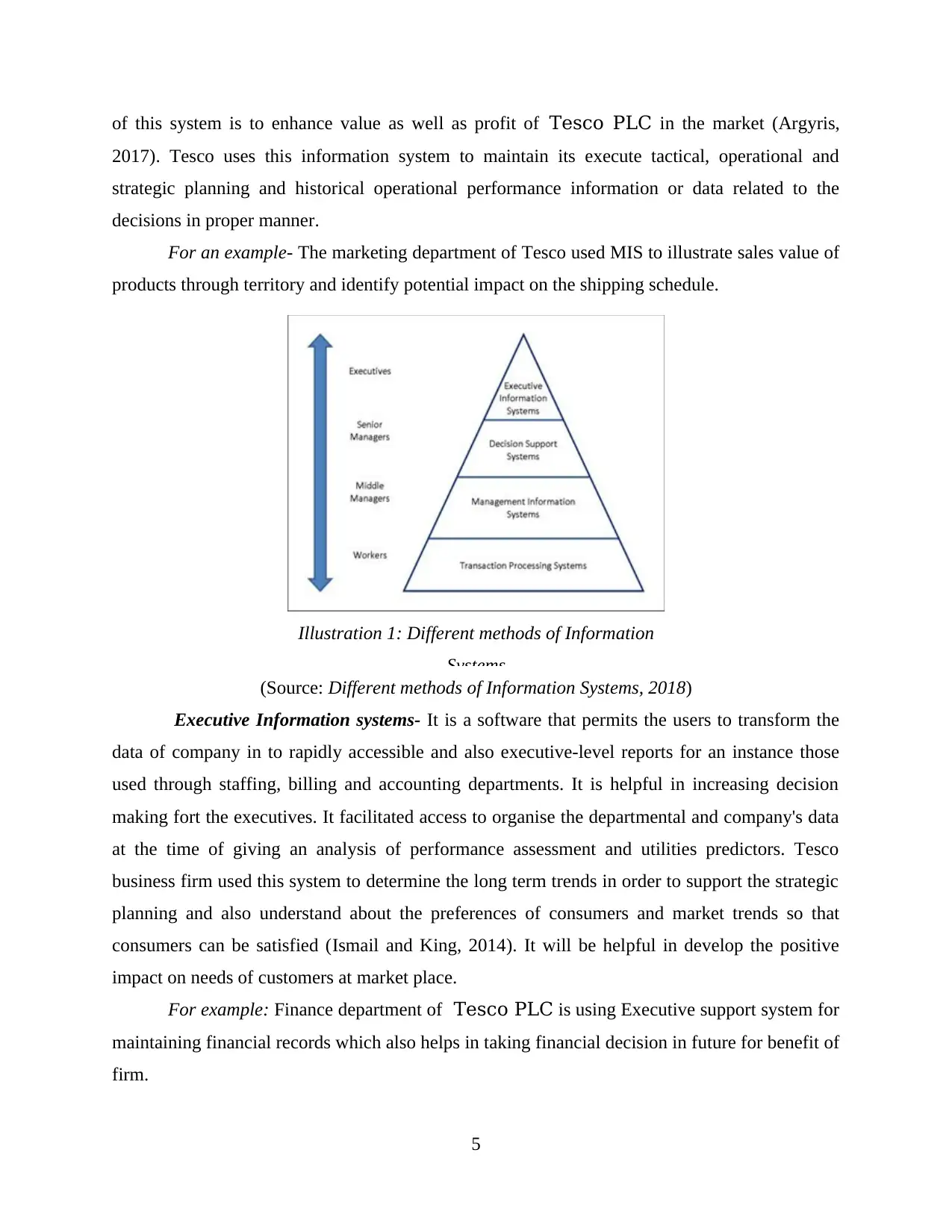
of this system is to enhance value as well as profit of Tesco PLC in the market (Argyris,
2017). Tesco uses this information system to maintain its execute tactical, operational and
strategic planning and historical operational performance information or data related to the
decisions in proper manner.
For an example- The marketing department of Tesco used MIS to illustrate sales value of
products through territory and identify potential impact on the shipping schedule.
(Source: Different methods of Information Systems, 2018)
Executive Information systems- It is a software that permits the users to transform the
data of company in to rapidly accessible and also executive-level reports for an instance those
used through staffing, billing and accounting departments. It is helpful in increasing decision
making fort the executives. It facilitated access to organise the departmental and company's data
at the time of giving an analysis of performance assessment and utilities predictors. Tesco
business firm used this system to determine the long term trends in order to support the strategic
planning and also understand about the preferences of consumers and market trends so that
consumers can be satisfied (Ismail and King, 2014). It will be helpful in develop the positive
impact on needs of customers at market place.
For example: Finance department of Tesco PLC is using Executive support system for
maintaining financial records which also helps in taking financial decision in future for benefit of
firm.
5
Illustration 1: Different methods of Information
Systems
2017). Tesco uses this information system to maintain its execute tactical, operational and
strategic planning and historical operational performance information or data related to the
decisions in proper manner.
For an example- The marketing department of Tesco used MIS to illustrate sales value of
products through territory and identify potential impact on the shipping schedule.
(Source: Different methods of Information Systems, 2018)
Executive Information systems- It is a software that permits the users to transform the
data of company in to rapidly accessible and also executive-level reports for an instance those
used through staffing, billing and accounting departments. It is helpful in increasing decision
making fort the executives. It facilitated access to organise the departmental and company's data
at the time of giving an analysis of performance assessment and utilities predictors. Tesco
business firm used this system to determine the long term trends in order to support the strategic
planning and also understand about the preferences of consumers and market trends so that
consumers can be satisfied (Ismail and King, 2014). It will be helpful in develop the positive
impact on needs of customers at market place.
For example: Finance department of Tesco PLC is using Executive support system for
maintaining financial records which also helps in taking financial decision in future for benefit of
firm.
5
Illustration 1: Different methods of Information
Systems
Paraphrase This Document
Need a fresh take? Get an instant paraphrase of this document with our AI Paraphraser
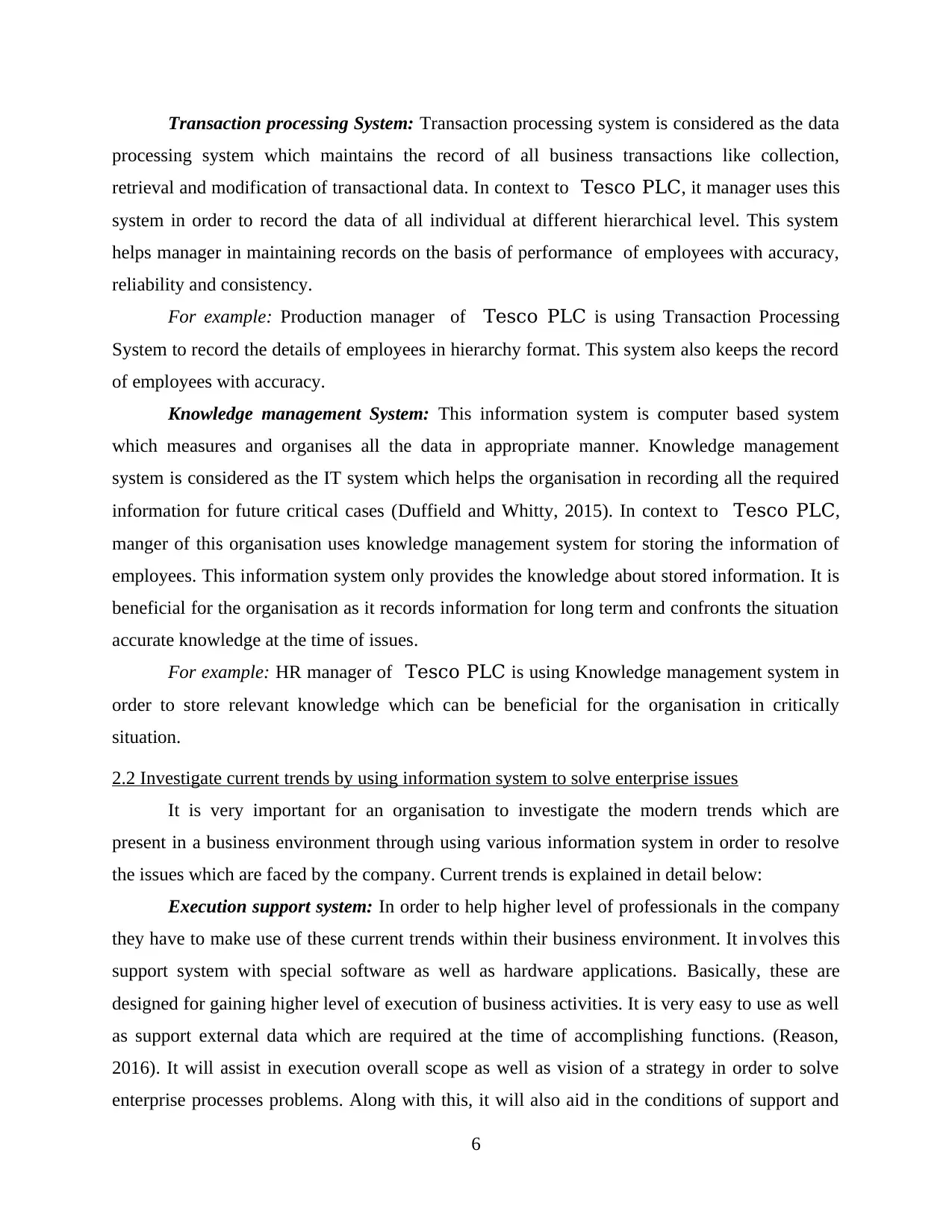
Transaction processing System: Transaction processing system is considered as the data
processing system which maintains the record of all business transactions like collection,
retrieval and modification of transactional data. In context to Tesco PLC, it manager uses this
system in order to record the data of all individual at different hierarchical level. This system
helps manager in maintaining records on the basis of performance of employees with accuracy,
reliability and consistency.
For example: Production manager of Tesco PLC is using Transaction Processing
System to record the details of employees in hierarchy format. This system also keeps the record
of employees with accuracy.
Knowledge management System: This information system is computer based system
which measures and organises all the data in appropriate manner. Knowledge management
system is considered as the IT system which helps the organisation in recording all the required
information for future critical cases (Duffield and Whitty, 2015). In context to Tesco PLC,
manger of this organisation uses knowledge management system for storing the information of
employees. This information system only provides the knowledge about stored information. It is
beneficial for the organisation as it records information for long term and confronts the situation
accurate knowledge at the time of issues.
For example: HR manager of Tesco PLC is using Knowledge management system in
order to store relevant knowledge which can be beneficial for the organisation in critically
situation.
2.2 Investigate current trends by using information system to solve enterprise issues
It is very important for an organisation to investigate the modern trends which are
present in a business environment through using various information system in order to resolve
the issues which are faced by the company. Current trends is explained in detail below:
Execution support system: In order to help higher level of professionals in the company
they have to make use of these current trends within their business environment. It involves this
support system with special software as well as hardware applications. Basically, these are
designed for gaining higher level of execution of business activities. It is very easy to use as well
as support external data which are required at the time of accomplishing functions. (Reason,
2016). It will assist in execution overall scope as well as vision of a strategy in order to solve
enterprise processes problems. Along with this, it will also aid in the conditions of support and
6
processing system which maintains the record of all business transactions like collection,
retrieval and modification of transactional data. In context to Tesco PLC, it manager uses this
system in order to record the data of all individual at different hierarchical level. This system
helps manager in maintaining records on the basis of performance of employees with accuracy,
reliability and consistency.
For example: Production manager of Tesco PLC is using Transaction Processing
System to record the details of employees in hierarchy format. This system also keeps the record
of employees with accuracy.
Knowledge management System: This information system is computer based system
which measures and organises all the data in appropriate manner. Knowledge management
system is considered as the IT system which helps the organisation in recording all the required
information for future critical cases (Duffield and Whitty, 2015). In context to Tesco PLC,
manger of this organisation uses knowledge management system for storing the information of
employees. This information system only provides the knowledge about stored information. It is
beneficial for the organisation as it records information for long term and confronts the situation
accurate knowledge at the time of issues.
For example: HR manager of Tesco PLC is using Knowledge management system in
order to store relevant knowledge which can be beneficial for the organisation in critically
situation.
2.2 Investigate current trends by using information system to solve enterprise issues
It is very important for an organisation to investigate the modern trends which are
present in a business environment through using various information system in order to resolve
the issues which are faced by the company. Current trends is explained in detail below:
Execution support system: In order to help higher level of professionals in the company
they have to make use of these current trends within their business environment. It involves this
support system with special software as well as hardware applications. Basically, these are
designed for gaining higher level of execution of business activities. It is very easy to use as well
as support external data which are required at the time of accomplishing functions. (Reason,
2016). It will assist in execution overall scope as well as vision of a strategy in order to solve
enterprise processes problems. Along with this, it will also aid in the conditions of support and
6
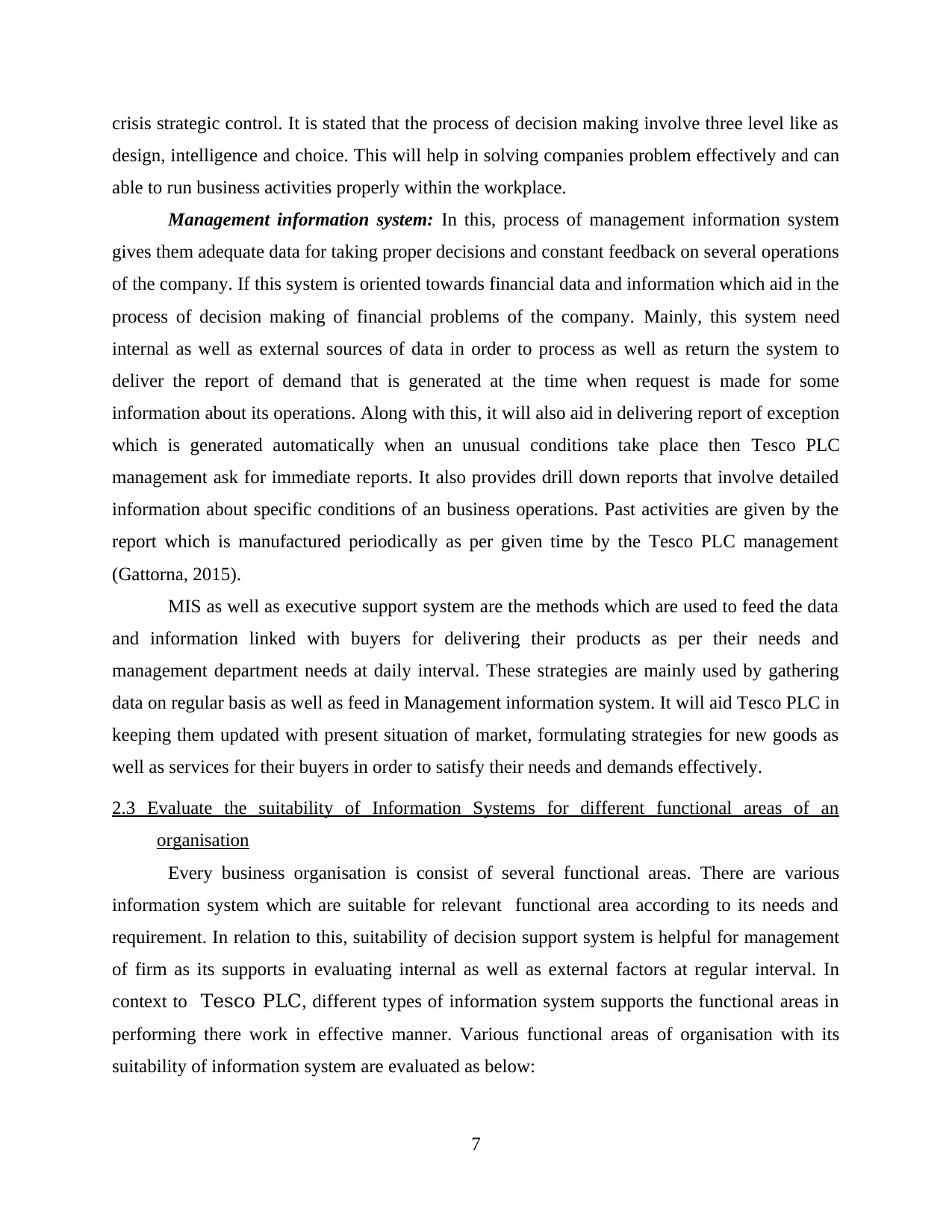
crisis strategic control. It is stated that the process of decision making involve three level like as
design, intelligence and choice. This will help in solving companies problem effectively and can
able to run business activities properly within the workplace.
Management information system: In this, process of management information system
gives them adequate data for taking proper decisions and constant feedback on several operations
of the company. If this system is oriented towards financial data and information which aid in the
process of decision making of financial problems of the company. Mainly, this system need
internal as well as external sources of data in order to process as well as return the system to
deliver the report of demand that is generated at the time when request is made for some
information about its operations. Along with this, it will also aid in delivering report of exception
which is generated automatically when an unusual conditions take place then Tesco PLC
management ask for immediate reports. It also provides drill down reports that involve detailed
information about specific conditions of an business operations. Past activities are given by the
report which is manufactured periodically as per given time by the Tesco PLC management
(Gattorna, 2015).
MIS as well as executive support system are the methods which are used to feed the data
and information linked with buyers for delivering their products as per their needs and
management department needs at daily interval. These strategies are mainly used by gathering
data on regular basis as well as feed in Management information system. It will aid Tesco PLC in
keeping them updated with present situation of market, formulating strategies for new goods as
well as services for their buyers in order to satisfy their needs and demands effectively.
2.3 Evaluate the suitability of Information Systems for different functional areas of an
organisation
Every business organisation is consist of several functional areas. There are various
information system which are suitable for relevant functional area according to its needs and
requirement. In relation to this, suitability of decision support system is helpful for management
of firm as its supports in evaluating internal as well as external factors at regular interval. In
context to Tesco PLC, different types of information system supports the functional areas in
performing there work in effective manner. Various functional areas of organisation with its
suitability of information system are evaluated as below:
7
design, intelligence and choice. This will help in solving companies problem effectively and can
able to run business activities properly within the workplace.
Management information system: In this, process of management information system
gives them adequate data for taking proper decisions and constant feedback on several operations
of the company. If this system is oriented towards financial data and information which aid in the
process of decision making of financial problems of the company. Mainly, this system need
internal as well as external sources of data in order to process as well as return the system to
deliver the report of demand that is generated at the time when request is made for some
information about its operations. Along with this, it will also aid in delivering report of exception
which is generated automatically when an unusual conditions take place then Tesco PLC
management ask for immediate reports. It also provides drill down reports that involve detailed
information about specific conditions of an business operations. Past activities are given by the
report which is manufactured periodically as per given time by the Tesco PLC management
(Gattorna, 2015).
MIS as well as executive support system are the methods which are used to feed the data
and information linked with buyers for delivering their products as per their needs and
management department needs at daily interval. These strategies are mainly used by gathering
data on regular basis as well as feed in Management information system. It will aid Tesco PLC in
keeping them updated with present situation of market, formulating strategies for new goods as
well as services for their buyers in order to satisfy their needs and demands effectively.
2.3 Evaluate the suitability of Information Systems for different functional areas of an
organisation
Every business organisation is consist of several functional areas. There are various
information system which are suitable for relevant functional area according to its needs and
requirement. In relation to this, suitability of decision support system is helpful for management
of firm as its supports in evaluating internal as well as external factors at regular interval. In
context to Tesco PLC, different types of information system supports the functional areas in
performing there work in effective manner. Various functional areas of organisation with its
suitability of information system are evaluated as below:
7
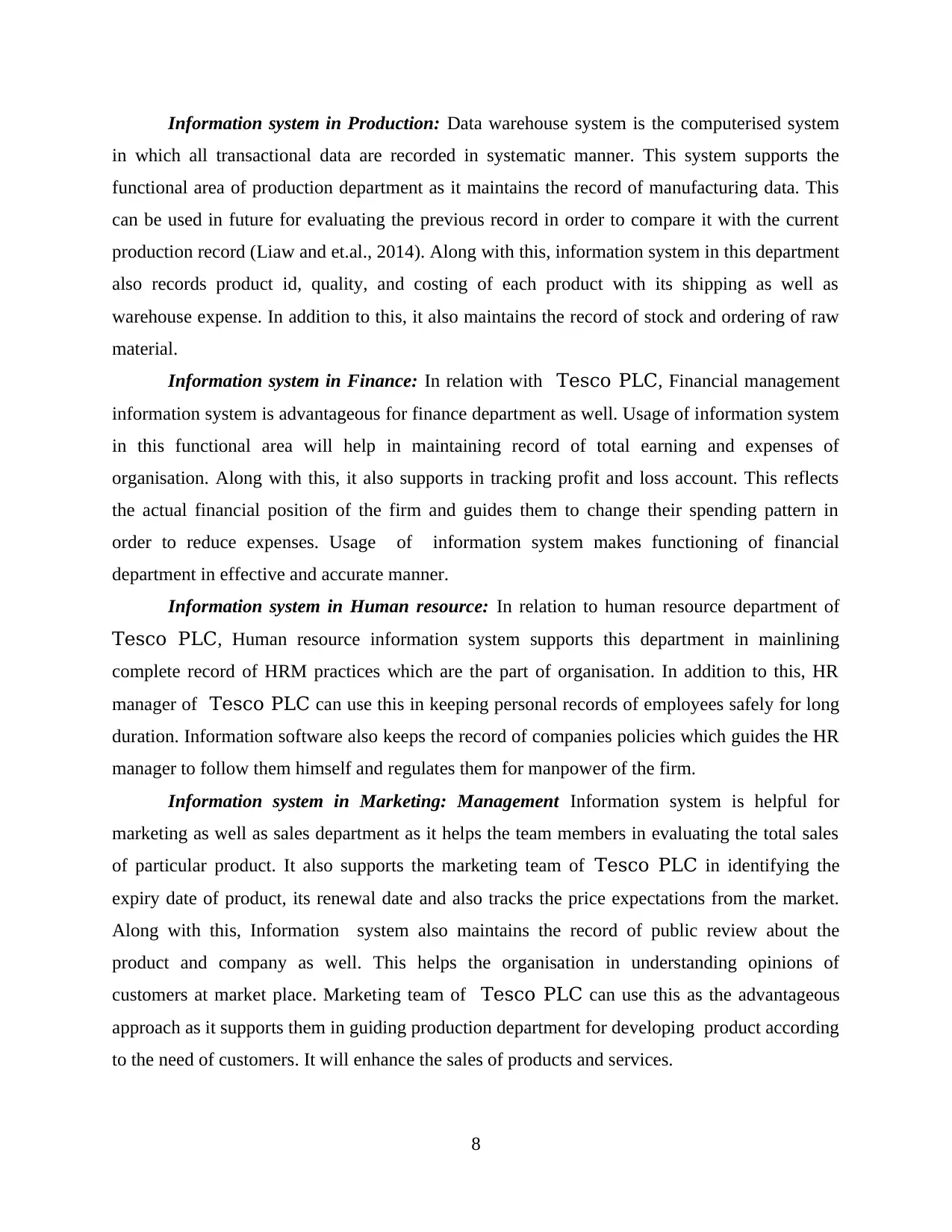
Information system in Production: Data warehouse system is the computerised system
in which all transactional data are recorded in systematic manner. This system supports the
functional area of production department as it maintains the record of manufacturing data. This
can be used in future for evaluating the previous record in order to compare it with the current
production record (Liaw and et.al., 2014). Along with this, information system in this department
also records product id, quality, and costing of each product with its shipping as well as
warehouse expense. In addition to this, it also maintains the record of stock and ordering of raw
material.
Information system in Finance: In relation with Tesco PLC, Financial management
information system is advantageous for finance department as well. Usage of information system
in this functional area will help in maintaining record of total earning and expenses of
organisation. Along with this, it also supports in tracking profit and loss account. This reflects
the actual financial position of the firm and guides them to change their spending pattern in
order to reduce expenses. Usage of information system makes functioning of financial
department in effective and accurate manner.
Information system in Human resource: In relation to human resource department of
Tesco PLC, Human resource information system supports this department in mainlining
complete record of HRM practices which are the part of organisation. In addition to this, HR
manager of Tesco PLC can use this in keeping personal records of employees safely for long
duration. Information software also keeps the record of companies policies which guides the HR
manager to follow them himself and regulates them for manpower of the firm.
Information system in Marketing: Management Information system is helpful for
marketing as well as sales department as it helps the team members in evaluating the total sales
of particular product. It also supports the marketing team of Tesco PLC in identifying the
expiry date of product, its renewal date and also tracks the price expectations from the market.
Along with this, Information system also maintains the record of public review about the
product and company as well. This helps the organisation in understanding opinions of
customers at market place. Marketing team of Tesco PLC can use this as the advantageous
approach as it supports them in guiding production department for developing product according
to the need of customers. It will enhance the sales of products and services.
8
in which all transactional data are recorded in systematic manner. This system supports the
functional area of production department as it maintains the record of manufacturing data. This
can be used in future for evaluating the previous record in order to compare it with the current
production record (Liaw and et.al., 2014). Along with this, information system in this department
also records product id, quality, and costing of each product with its shipping as well as
warehouse expense. In addition to this, it also maintains the record of stock and ordering of raw
material.
Information system in Finance: In relation with Tesco PLC, Financial management
information system is advantageous for finance department as well. Usage of information system
in this functional area will help in maintaining record of total earning and expenses of
organisation. Along with this, it also supports in tracking profit and loss account. This reflects
the actual financial position of the firm and guides them to change their spending pattern in
order to reduce expenses. Usage of information system makes functioning of financial
department in effective and accurate manner.
Information system in Human resource: In relation to human resource department of
Tesco PLC, Human resource information system supports this department in mainlining
complete record of HRM practices which are the part of organisation. In addition to this, HR
manager of Tesco PLC can use this in keeping personal records of employees safely for long
duration. Information software also keeps the record of companies policies which guides the HR
manager to follow them himself and regulates them for manpower of the firm.
Information system in Marketing: Management Information system is helpful for
marketing as well as sales department as it helps the team members in evaluating the total sales
of particular product. It also supports the marketing team of Tesco PLC in identifying the
expiry date of product, its renewal date and also tracks the price expectations from the market.
Along with this, Information system also maintains the record of public review about the
product and company as well. This helps the organisation in understanding opinions of
customers at market place. Marketing team of Tesco PLC can use this as the advantageous
approach as it supports them in guiding production department for developing product according
to the need of customers. It will enhance the sales of products and services.
8
Secure Best Marks with AI Grader
Need help grading? Try our AI Grader for instant feedback on your assignments.
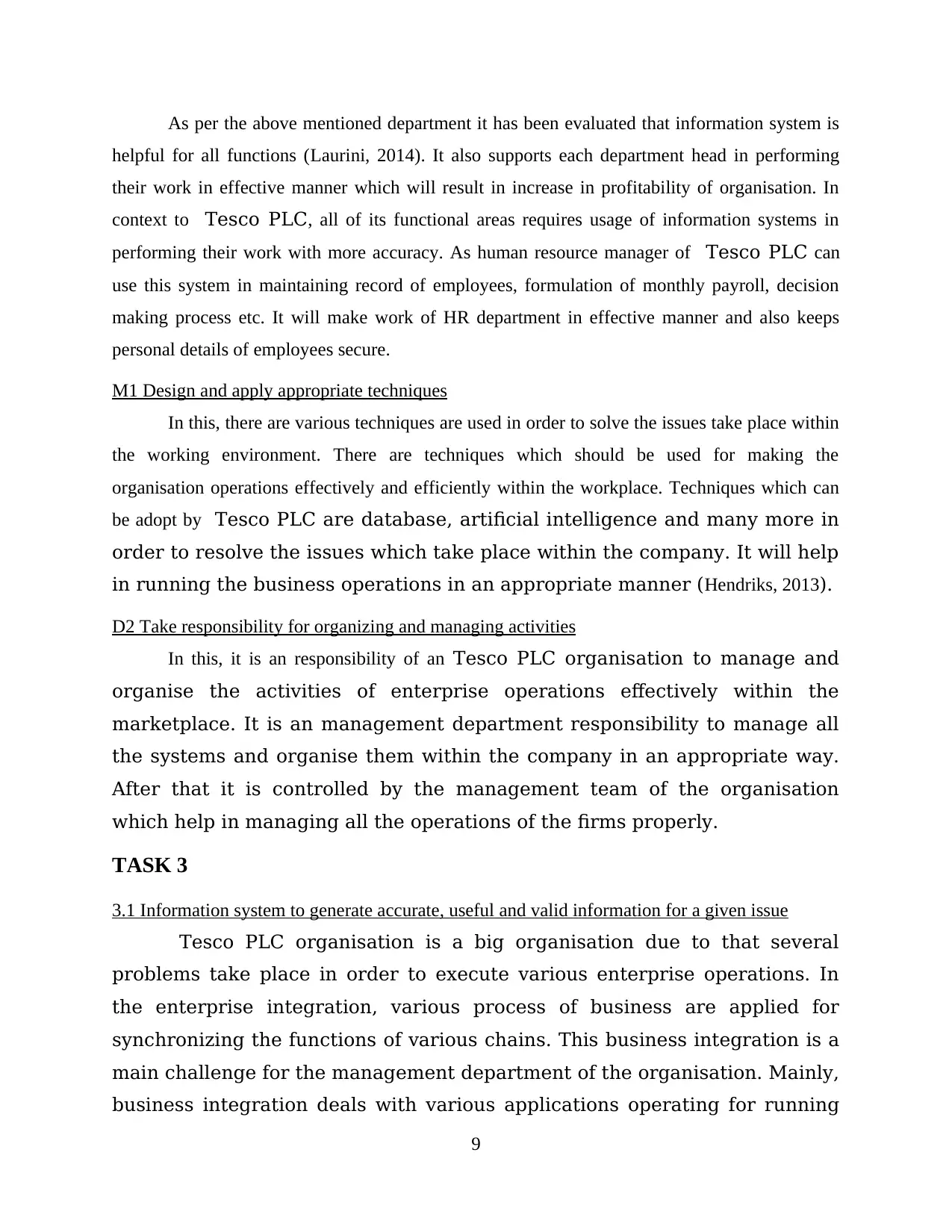
As per the above mentioned department it has been evaluated that information system is
helpful for all functions (Laurini, 2014). It also supports each department head in performing
their work in effective manner which will result in increase in profitability of organisation. In
context to Tesco PLC, all of its functional areas requires usage of information systems in
performing their work with more accuracy. As human resource manager of Tesco PLC can
use this system in maintaining record of employees, formulation of monthly payroll, decision
making process etc. It will make work of HR department in effective manner and also keeps
personal details of employees secure.
M1 Design and apply appropriate techniques
In this, there are various techniques are used in order to solve the issues take place within
the working environment. There are techniques which should be used for making the
organisation operations effectively and efficiently within the workplace. Techniques which can
be adopt by Tesco PLC are database, artificial intelligence and many more in
order to resolve the issues which take place within the company. It will help
in running the business operations in an appropriate manner (Hendriks, 2013).
D2 Take responsibility for organizing and managing activities
In this, it is an responsibility of an Tesco PLC organisation to manage and
organise the activities of enterprise operations effectively within the
marketplace. It is an management department responsibility to manage all
the systems and organise them within the company in an appropriate way.
After that it is controlled by the management team of the organisation
which help in managing all the operations of the firms properly.
TASK 3
3.1 Information system to generate accurate, useful and valid information for a given issue
Tesco PLC organisation is a big organisation due to that several
problems take place in order to execute various enterprise operations. In
the enterprise integration, various process of business are applied for
synchronizing the functions of various chains. This business integration is a
main challenge for the management department of the organisation. Mainly,
business integration deals with various applications operating for running
9
helpful for all functions (Laurini, 2014). It also supports each department head in performing
their work in effective manner which will result in increase in profitability of organisation. In
context to Tesco PLC, all of its functional areas requires usage of information systems in
performing their work with more accuracy. As human resource manager of Tesco PLC can
use this system in maintaining record of employees, formulation of monthly payroll, decision
making process etc. It will make work of HR department in effective manner and also keeps
personal details of employees secure.
M1 Design and apply appropriate techniques
In this, there are various techniques are used in order to solve the issues take place within
the working environment. There are techniques which should be used for making the
organisation operations effectively and efficiently within the workplace. Techniques which can
be adopt by Tesco PLC are database, artificial intelligence and many more in
order to resolve the issues which take place within the company. It will help
in running the business operations in an appropriate manner (Hendriks, 2013).
D2 Take responsibility for organizing and managing activities
In this, it is an responsibility of an Tesco PLC organisation to manage and
organise the activities of enterprise operations effectively within the
marketplace. It is an management department responsibility to manage all
the systems and organise them within the company in an appropriate way.
After that it is controlled by the management team of the organisation
which help in managing all the operations of the firms properly.
TASK 3
3.1 Information system to generate accurate, useful and valid information for a given issue
Tesco PLC organisation is a big organisation due to that several
problems take place in order to execute various enterprise operations. In
the enterprise integration, various process of business are applied for
synchronizing the functions of various chains. This business integration is a
main challenge for the management department of the organisation. Mainly,
business integration deals with various applications operating for running
9
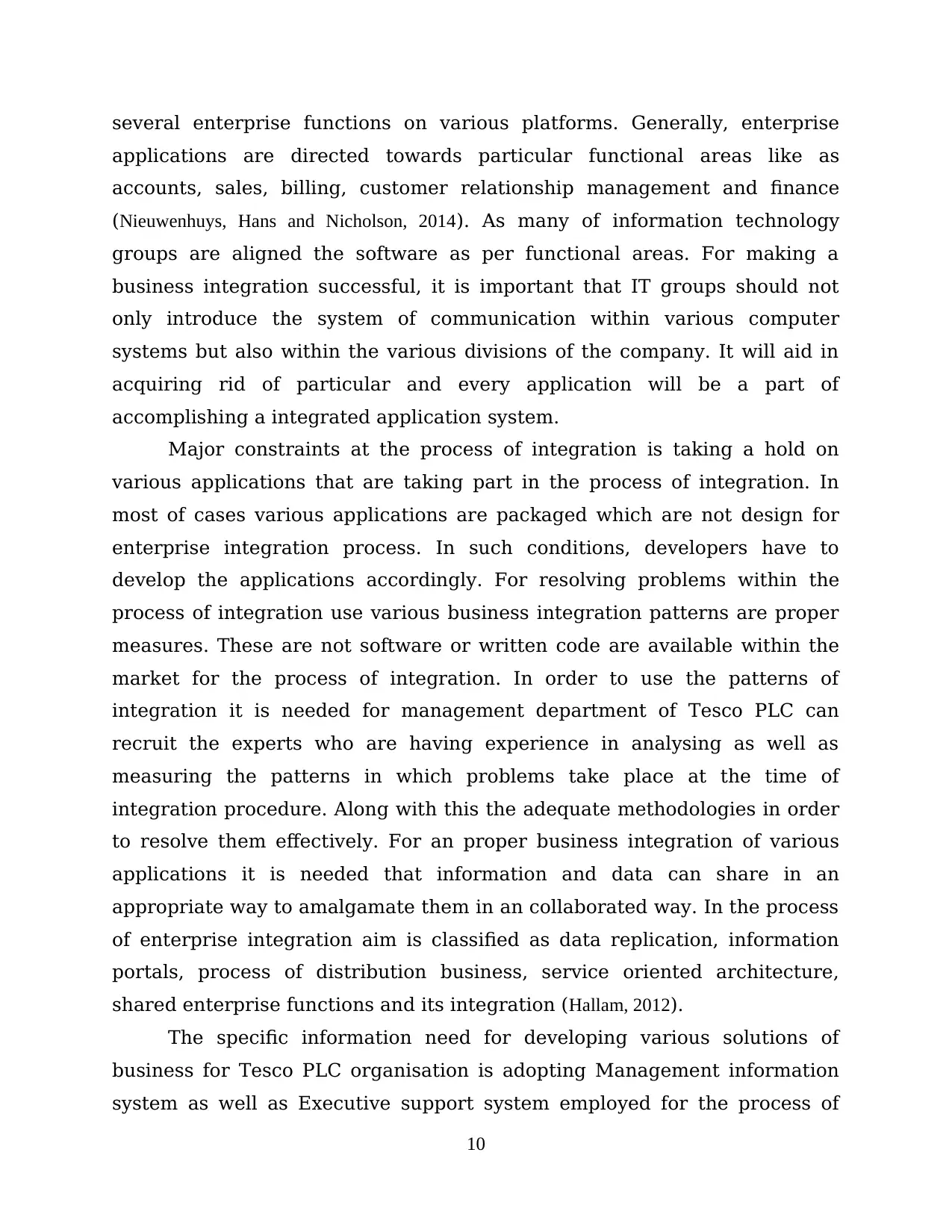
several enterprise functions on various platforms. Generally, enterprise
applications are directed towards particular functional areas like as
accounts, sales, billing, customer relationship management and finance
(Nieuwenhuys, Hans and Nicholson, 2014). As many of information technology
groups are aligned the software as per functional areas. For making a
business integration successful, it is important that IT groups should not
only introduce the system of communication within various computer
systems but also within the various divisions of the company. It will aid in
acquiring rid of particular and every application will be a part of
accomplishing a integrated application system.
Major constraints at the process of integration is taking a hold on
various applications that are taking part in the process of integration. In
most of cases various applications are packaged which are not design for
enterprise integration process. In such conditions, developers have to
develop the applications accordingly. For resolving problems within the
process of integration use various business integration patterns are proper
measures. These are not software or written code are available within the
market for the process of integration. In order to use the patterns of
integration it is needed for management department of Tesco PLC can
recruit the experts who are having experience in analysing as well as
measuring the patterns in which problems take place at the time of
integration procedure. Along with this the adequate methodologies in order
to resolve them effectively. For an proper business integration of various
applications it is needed that information and data can share in an
appropriate way to amalgamate them in an collaborated way. In the process
of enterprise integration aim is classified as data replication, information
portals, process of distribution business, service oriented architecture,
shared enterprise functions and its integration (Hallam, 2012).
The specific information need for developing various solutions of
business for Tesco PLC organisation is adopting Management information
system as well as Executive support system employed for the process of
10
applications are directed towards particular functional areas like as
accounts, sales, billing, customer relationship management and finance
(Nieuwenhuys, Hans and Nicholson, 2014). As many of information technology
groups are aligned the software as per functional areas. For making a
business integration successful, it is important that IT groups should not
only introduce the system of communication within various computer
systems but also within the various divisions of the company. It will aid in
acquiring rid of particular and every application will be a part of
accomplishing a integrated application system.
Major constraints at the process of integration is taking a hold on
various applications that are taking part in the process of integration. In
most of cases various applications are packaged which are not design for
enterprise integration process. In such conditions, developers have to
develop the applications accordingly. For resolving problems within the
process of integration use various business integration patterns are proper
measures. These are not software or written code are available within the
market for the process of integration. In order to use the patterns of
integration it is needed for management department of Tesco PLC can
recruit the experts who are having experience in analysing as well as
measuring the patterns in which problems take place at the time of
integration procedure. Along with this the adequate methodologies in order
to resolve them effectively. For an proper business integration of various
applications it is needed that information and data can share in an
appropriate way to amalgamate them in an collaborated way. In the process
of enterprise integration aim is classified as data replication, information
portals, process of distribution business, service oriented architecture,
shared enterprise functions and its integration (Hallam, 2012).
The specific information need for developing various solutions of
business for Tesco PLC organisation is adopting Management information
system as well as Executive support system employed for the process of
10

decision making. Theses systems gathered data are handed to the
developers group for analysing the needed information and data that is
needed for developing synchronized business integration for Tesco PLC
organisation. These information and data is sent to data warehouse which is
located at the major headquarter of Tesco PLC company. This strategies or
methods will assist the developers in accessing the information to every as
well as each centres in an appropriate way along with this applications are
integrated accordingly.
Information system help in making decisions in order to generate effective information
used within the business operations. Tesco PLC are using the test models of
enterprises to monitor as well as enhance the performance of every
individual person. Various system used by the company in order to evaluate
and monitor the performance of every information systems. Their are
various alternative approaches for resolving issues are as follows: The Input Phase: In this, they input the information in the system in order get the
effective results they use the useful, accurate and valid information. The Processing Phase: After that, information is processing in order to show the
outcomes of given information. Implementation Phase: Then after processing then they apply the information system
within the business operation in order to enhance the individual person productivity.
The Review/Feedback Phase: after all these phases, they take the feedback and know the
outcomes that it is effective or not within the business operations.
3.2 Evaluate alternative approaches of solving problems
Business integration is important in order to generalizing the application flow of
company. Tesco PLC management team can use various alternative methodologies in order to
process various operations of different divisions through employing expert system, client server,
database and artificial intelligence at various centres. These methods are used in order to solve
identified problems which are as follows: Database: Various centres can use its own database in order to gather data for its centres
as well as analyse it for several enterprise operations of their centres. It is classified as per
the content organisation are designed to gather information from bibliographic, images,
11
developers group for analysing the needed information and data that is
needed for developing synchronized business integration for Tesco PLC
organisation. These information and data is sent to data warehouse which is
located at the major headquarter of Tesco PLC company. This strategies or
methods will assist the developers in accessing the information to every as
well as each centres in an appropriate way along with this applications are
integrated accordingly.
Information system help in making decisions in order to generate effective information
used within the business operations. Tesco PLC are using the test models of
enterprises to monitor as well as enhance the performance of every
individual person. Various system used by the company in order to evaluate
and monitor the performance of every information systems. Their are
various alternative approaches for resolving issues are as follows: The Input Phase: In this, they input the information in the system in order get the
effective results they use the useful, accurate and valid information. The Processing Phase: After that, information is processing in order to show the
outcomes of given information. Implementation Phase: Then after processing then they apply the information system
within the business operation in order to enhance the individual person productivity.
The Review/Feedback Phase: after all these phases, they take the feedback and know the
outcomes that it is effective or not within the business operations.
3.2 Evaluate alternative approaches of solving problems
Business integration is important in order to generalizing the application flow of
company. Tesco PLC management team can use various alternative methodologies in order to
process various operations of different divisions through employing expert system, client server,
database and artificial intelligence at various centres. These methods are used in order to solve
identified problems which are as follows: Database: Various centres can use its own database in order to gather data for its centres
as well as analyse it for several enterprise operations of their centres. It is classified as per
the content organisation are designed to gather information from bibliographic, images,
11
Paraphrase This Document
Need a fresh take? Get an instant paraphrase of this document with our AI Paraphraser
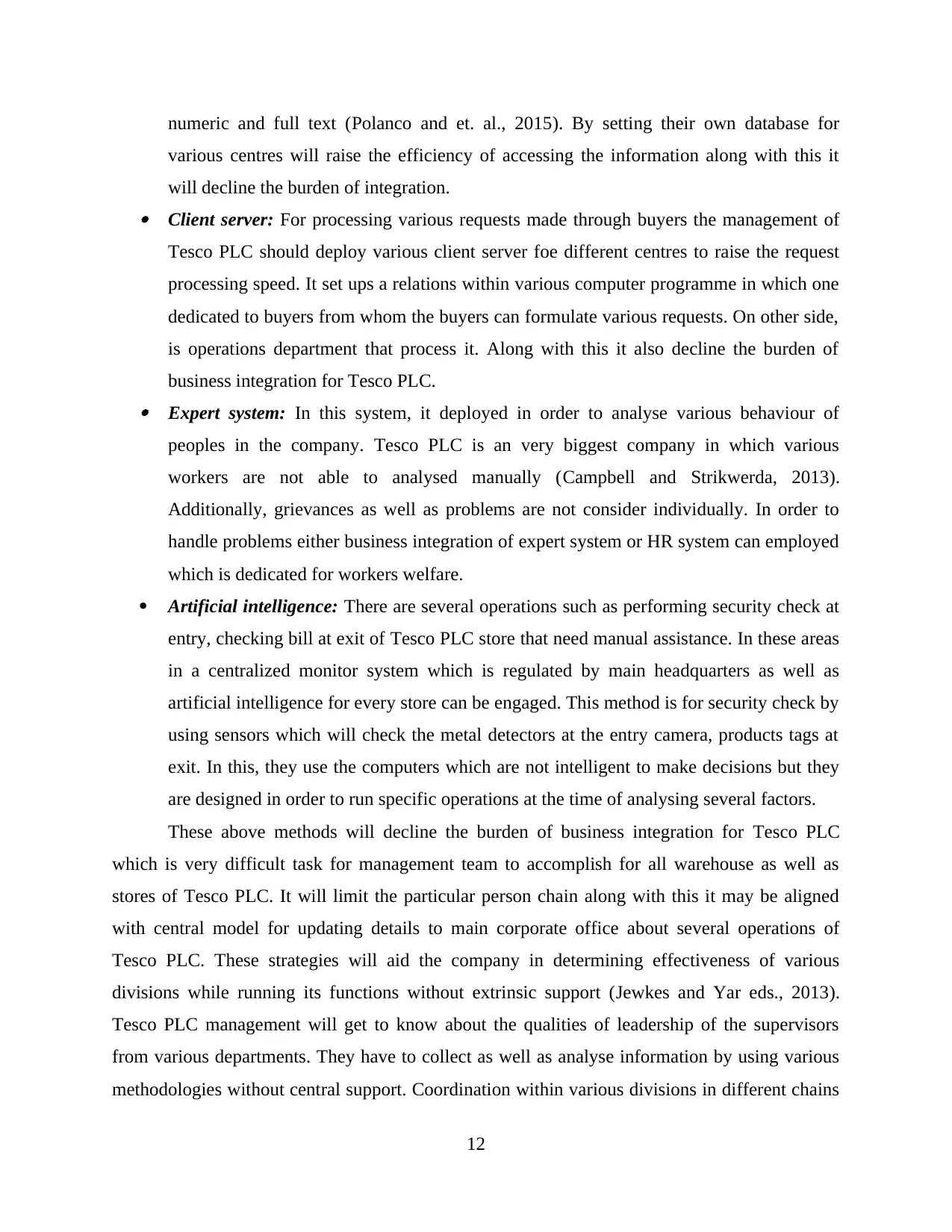
numeric and full text (Polanco and et. al., 2015). By setting their own database for
various centres will raise the efficiency of accessing the information along with this it
will decline the burden of integration. Client server: For processing various requests made through buyers the management of
Tesco PLC should deploy various client server foe different centres to raise the request
processing speed. It set ups a relations within various computer programme in which one
dedicated to buyers from whom the buyers can formulate various requests. On other side,
is operations department that process it. Along with this it also decline the burden of
business integration for Tesco PLC. Expert system: In this system, it deployed in order to analyse various behaviour of
peoples in the company. Tesco PLC is an very biggest company in which various
workers are not able to analysed manually (Campbell and Strikwerda, 2013).
Additionally, grievances as well as problems are not consider individually. In order to
handle problems either business integration of expert system or HR system can employed
which is dedicated for workers welfare.
Artificial intelligence: There are several operations such as performing security check at
entry, checking bill at exit of Tesco PLC store that need manual assistance. In these areas
in a centralized monitor system which is regulated by main headquarters as well as
artificial intelligence for every store can be engaged. This method is for security check by
using sensors which will check the metal detectors at the entry camera, products tags at
exit. In this, they use the computers which are not intelligent to make decisions but they
are designed in order to run specific operations at the time of analysing several factors.
These above methods will decline the burden of business integration for Tesco PLC
which is very difficult task for management team to accomplish for all warehouse as well as
stores of Tesco PLC. It will limit the particular person chain along with this it may be aligned
with central model for updating details to main corporate office about several operations of
Tesco PLC. These strategies will aid the company in determining effectiveness of various
divisions while running its functions without extrinsic support (Jewkes and Yar eds., 2013).
Tesco PLC management will get to know about the qualities of leadership of the supervisors
from various departments. They have to collect as well as analyse information by using various
methodologies without central support. Coordination within various divisions in different chains
12
various centres will raise the efficiency of accessing the information along with this it
will decline the burden of integration. Client server: For processing various requests made through buyers the management of
Tesco PLC should deploy various client server foe different centres to raise the request
processing speed. It set ups a relations within various computer programme in which one
dedicated to buyers from whom the buyers can formulate various requests. On other side,
is operations department that process it. Along with this it also decline the burden of
business integration for Tesco PLC. Expert system: In this system, it deployed in order to analyse various behaviour of
peoples in the company. Tesco PLC is an very biggest company in which various
workers are not able to analysed manually (Campbell and Strikwerda, 2013).
Additionally, grievances as well as problems are not consider individually. In order to
handle problems either business integration of expert system or HR system can employed
which is dedicated for workers welfare.
Artificial intelligence: There are several operations such as performing security check at
entry, checking bill at exit of Tesco PLC store that need manual assistance. In these areas
in a centralized monitor system which is regulated by main headquarters as well as
artificial intelligence for every store can be engaged. This method is for security check by
using sensors which will check the metal detectors at the entry camera, products tags at
exit. In this, they use the computers which are not intelligent to make decisions but they
are designed in order to run specific operations at the time of analysing several factors.
These above methods will decline the burden of business integration for Tesco PLC
which is very difficult task for management team to accomplish for all warehouse as well as
stores of Tesco PLC. It will limit the particular person chain along with this it may be aligned
with central model for updating details to main corporate office about several operations of
Tesco PLC. These strategies will aid the company in determining effectiveness of various
divisions while running its functions without extrinsic support (Jewkes and Yar eds., 2013).
Tesco PLC management will get to know about the qualities of leadership of the supervisors
from various departments. They have to collect as well as analyse information by using various
methodologies without central support. Coordination within various divisions in different chains
12
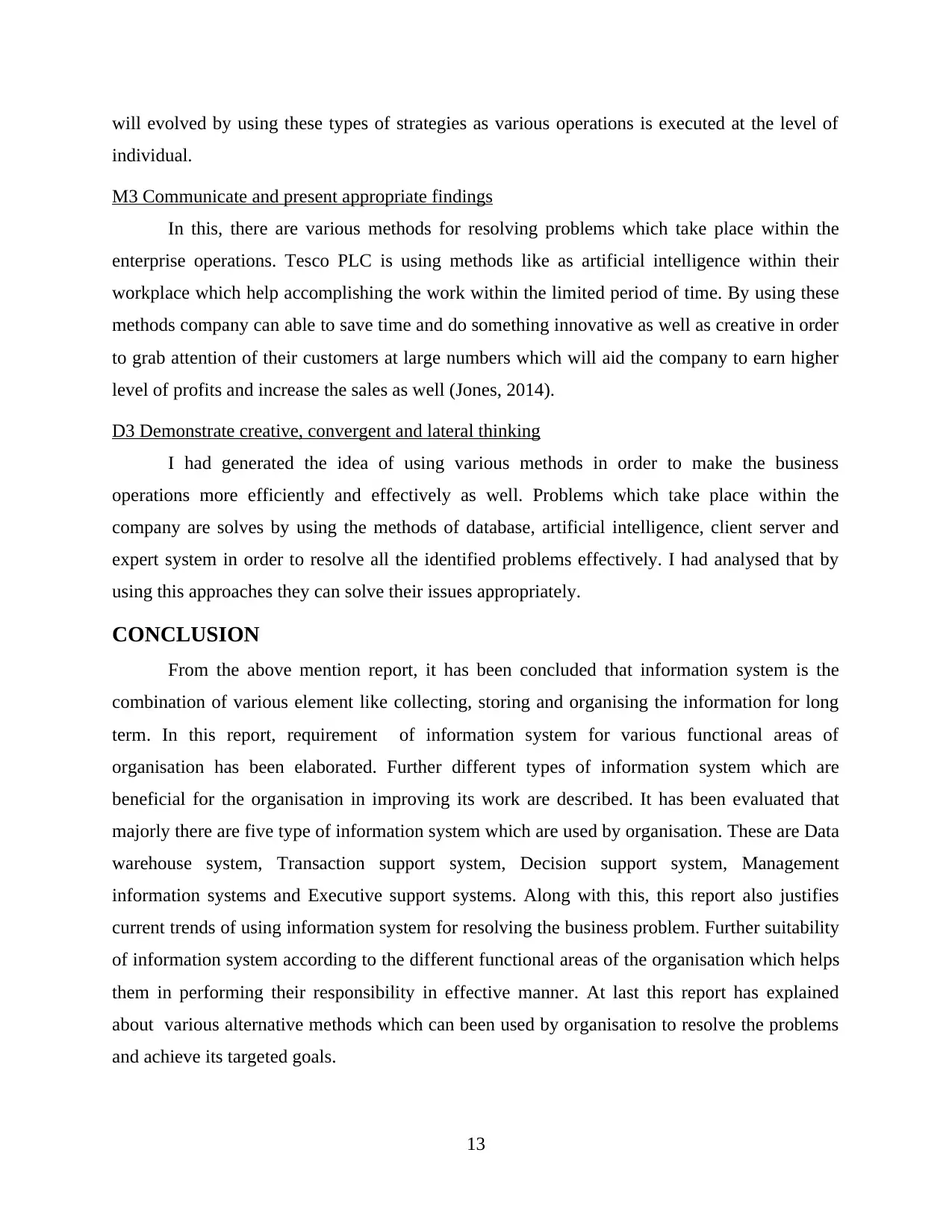
will evolved by using these types of strategies as various operations is executed at the level of
individual.
M3 Communicate and present appropriate findings
In this, there are various methods for resolving problems which take place within the
enterprise operations. Tesco PLC is using methods like as artificial intelligence within their
workplace which help accomplishing the work within the limited period of time. By using these
methods company can able to save time and do something innovative as well as creative in order
to grab attention of their customers at large numbers which will aid the company to earn higher
level of profits and increase the sales as well (Jones, 2014).
D3 Demonstrate creative, convergent and lateral thinking
I had generated the idea of using various methods in order to make the business
operations more efficiently and effectively as well. Problems which take place within the
company are solves by using the methods of database, artificial intelligence, client server and
expert system in order to resolve all the identified problems effectively. I had analysed that by
using this approaches they can solve their issues appropriately.
CONCLUSION
From the above mention report, it has been concluded that information system is the
combination of various element like collecting, storing and organising the information for long
term. In this report, requirement of information system for various functional areas of
organisation has been elaborated. Further different types of information system which are
beneficial for the organisation in improving its work are described. It has been evaluated that
majorly there are five type of information system which are used by organisation. These are Data
warehouse system, Transaction support system, Decision support system, Management
information systems and Executive support systems. Along with this, this report also justifies
current trends of using information system for resolving the business problem. Further suitability
of information system according to the different functional areas of the organisation which helps
them in performing their responsibility in effective manner. At last this report has explained
about various alternative methods which can been used by organisation to resolve the problems
and achieve its targeted goals.
13
individual.
M3 Communicate and present appropriate findings
In this, there are various methods for resolving problems which take place within the
enterprise operations. Tesco PLC is using methods like as artificial intelligence within their
workplace which help accomplishing the work within the limited period of time. By using these
methods company can able to save time and do something innovative as well as creative in order
to grab attention of their customers at large numbers which will aid the company to earn higher
level of profits and increase the sales as well (Jones, 2014).
D3 Demonstrate creative, convergent and lateral thinking
I had generated the idea of using various methods in order to make the business
operations more efficiently and effectively as well. Problems which take place within the
company are solves by using the methods of database, artificial intelligence, client server and
expert system in order to resolve all the identified problems effectively. I had analysed that by
using this approaches they can solve their issues appropriately.
CONCLUSION
From the above mention report, it has been concluded that information system is the
combination of various element like collecting, storing and organising the information for long
term. In this report, requirement of information system for various functional areas of
organisation has been elaborated. Further different types of information system which are
beneficial for the organisation in improving its work are described. It has been evaluated that
majorly there are five type of information system which are used by organisation. These are Data
warehouse system, Transaction support system, Decision support system, Management
information systems and Executive support systems. Along with this, this report also justifies
current trends of using information system for resolving the business problem. Further suitability
of information system according to the different functional areas of the organisation which helps
them in performing their responsibility in effective manner. At last this report has explained
about various alternative methods which can been used by organisation to resolve the problems
and achieve its targeted goals.
13
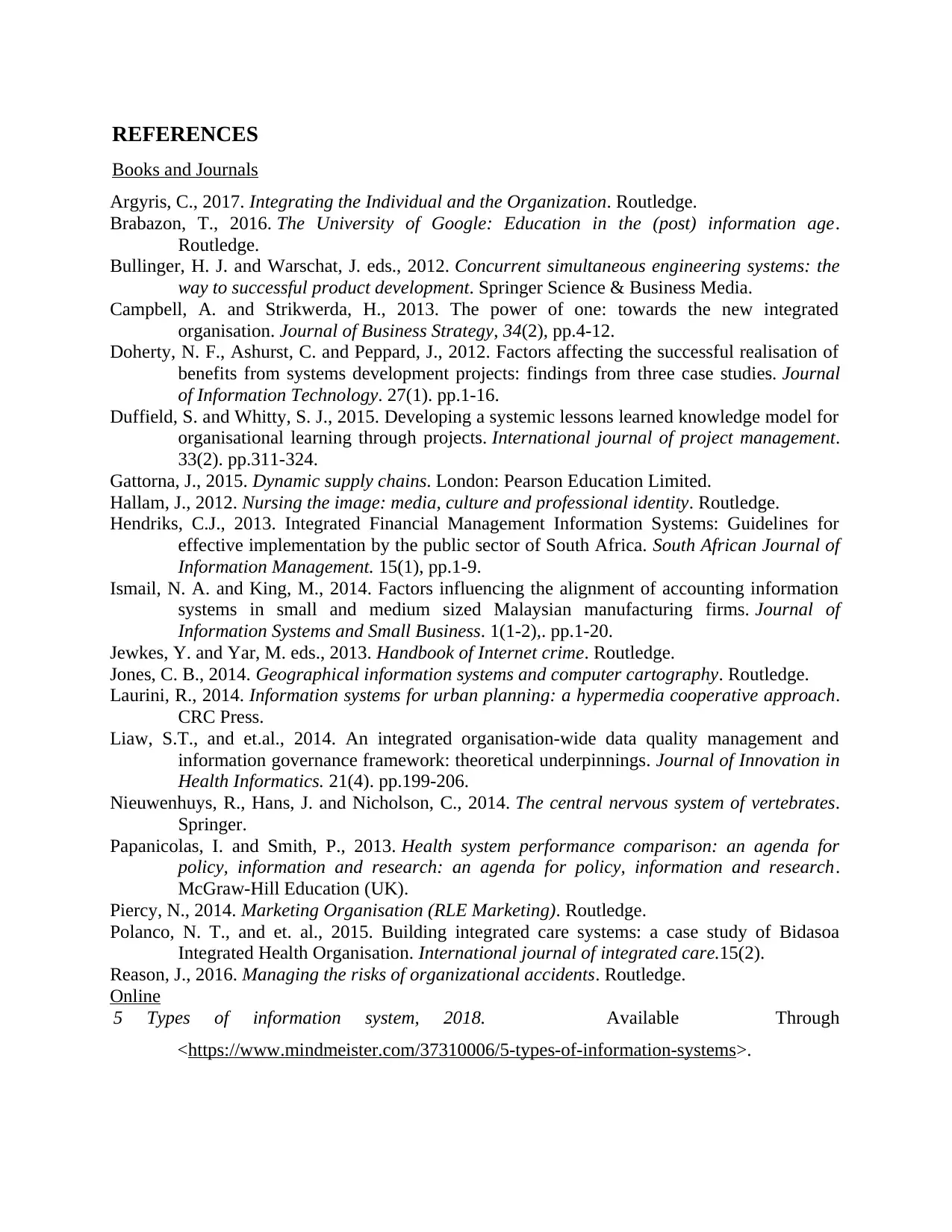
REFERENCES
Books and Journals
Argyris, C., 2017. Integrating the Individual and the Organization. Routledge.
Brabazon, T., 2016. The University of Google: Education in the (post) information age.
Routledge.
Bullinger, H. J. and Warschat, J. eds., 2012. Concurrent simultaneous engineering systems: the
way to successful product development. Springer Science & Business Media.
Campbell, A. and Strikwerda, H., 2013. The power of one: towards the new integrated
organisation. Journal of Business Strategy, 34(2), pp.4-12.
Doherty, N. F., Ashurst, C. and Peppard, J., 2012. Factors affecting the successful realisation of
benefits from systems development projects: findings from three case studies. Journal
of Information Technology. 27(1). pp.1-16.
Duffield, S. and Whitty, S. J., 2015. Developing a systemic lessons learned knowledge model for
organisational learning through projects. International journal of project management.
33(2). pp.311-324.
Gattorna, J., 2015. Dynamic supply chains. London: Pearson Education Limited.
Hallam, J., 2012. Nursing the image: media, culture and professional identity. Routledge.
Hendriks, C.J., 2013. Integrated Financial Management Information Systems: Guidelines for
effective implementation by the public sector of South Africa. South African Journal of
Information Management. 15(1), pp.1-9.
Ismail, N. A. and King, M., 2014. Factors influencing the alignment of accounting information
systems in small and medium sized Malaysian manufacturing firms. Journal of
Information Systems and Small Business. 1(1-2),. pp.1-20.
Jewkes, Y. and Yar, M. eds., 2013. Handbook of Internet crime. Routledge.
Jones, C. B., 2014. Geographical information systems and computer cartography. Routledge.
Laurini, R., 2014. Information systems for urban planning: a hypermedia cooperative approach.
CRC Press.
Liaw, S.T., and et.al., 2014. An integrated organisation-wide data quality management and
information governance framework: theoretical underpinnings. Journal of Innovation in
Health Informatics. 21(4). pp.199-206.
Nieuwenhuys, R., Hans, J. and Nicholson, C., 2014. The central nervous system of vertebrates.
Springer.
Papanicolas, I. and Smith, P., 2013. Health system performance comparison: an agenda for
policy, information and research: an agenda for policy, information and research.
McGraw-Hill Education (UK).
Piercy, N., 2014. Marketing Organisation (RLE Marketing). Routledge.
Polanco, N. T., and et. al., 2015. Building integrated care systems: a case study of Bidasoa
Integrated Health Organisation. International journal of integrated care.15(2).
Reason, J., 2016. Managing the risks of organizational accidents. Routledge.
Online
5 Types of information system, 2018. Available Through
<https://www.mindmeister.com/37310006/5-types-of-information-systems>.
Books and Journals
Argyris, C., 2017. Integrating the Individual and the Organization. Routledge.
Brabazon, T., 2016. The University of Google: Education in the (post) information age.
Routledge.
Bullinger, H. J. and Warschat, J. eds., 2012. Concurrent simultaneous engineering systems: the
way to successful product development. Springer Science & Business Media.
Campbell, A. and Strikwerda, H., 2013. The power of one: towards the new integrated
organisation. Journal of Business Strategy, 34(2), pp.4-12.
Doherty, N. F., Ashurst, C. and Peppard, J., 2012. Factors affecting the successful realisation of
benefits from systems development projects: findings from three case studies. Journal
of Information Technology. 27(1). pp.1-16.
Duffield, S. and Whitty, S. J., 2015. Developing a systemic lessons learned knowledge model for
organisational learning through projects. International journal of project management.
33(2). pp.311-324.
Gattorna, J., 2015. Dynamic supply chains. London: Pearson Education Limited.
Hallam, J., 2012. Nursing the image: media, culture and professional identity. Routledge.
Hendriks, C.J., 2013. Integrated Financial Management Information Systems: Guidelines for
effective implementation by the public sector of South Africa. South African Journal of
Information Management. 15(1), pp.1-9.
Ismail, N. A. and King, M., 2014. Factors influencing the alignment of accounting information
systems in small and medium sized Malaysian manufacturing firms. Journal of
Information Systems and Small Business. 1(1-2),. pp.1-20.
Jewkes, Y. and Yar, M. eds., 2013. Handbook of Internet crime. Routledge.
Jones, C. B., 2014. Geographical information systems and computer cartography. Routledge.
Laurini, R., 2014. Information systems for urban planning: a hypermedia cooperative approach.
CRC Press.
Liaw, S.T., and et.al., 2014. An integrated organisation-wide data quality management and
information governance framework: theoretical underpinnings. Journal of Innovation in
Health Informatics. 21(4). pp.199-206.
Nieuwenhuys, R., Hans, J. and Nicholson, C., 2014. The central nervous system of vertebrates.
Springer.
Papanicolas, I. and Smith, P., 2013. Health system performance comparison: an agenda for
policy, information and research: an agenda for policy, information and research.
McGraw-Hill Education (UK).
Piercy, N., 2014. Marketing Organisation (RLE Marketing). Routledge.
Polanco, N. T., and et. al., 2015. Building integrated care systems: a case study of Bidasoa
Integrated Health Organisation. International journal of integrated care.15(2).
Reason, J., 2016. Managing the risks of organizational accidents. Routledge.
Online
5 Types of information system, 2018. Available Through
<https://www.mindmeister.com/37310006/5-types-of-information-systems>.
Secure Best Marks with AI Grader
Need help grading? Try our AI Grader for instant feedback on your assignments.

2
1 out of 17
Related Documents
Your All-in-One AI-Powered Toolkit for Academic Success.
+13062052269
info@desklib.com
Available 24*7 on WhatsApp / Email
![[object Object]](/_next/static/media/star-bottom.7253800d.svg)
Unlock your academic potential
© 2024 | Zucol Services PVT LTD | All rights reserved.





